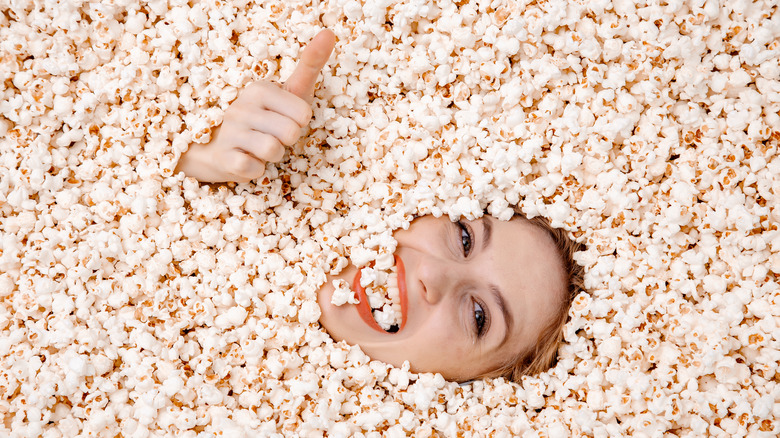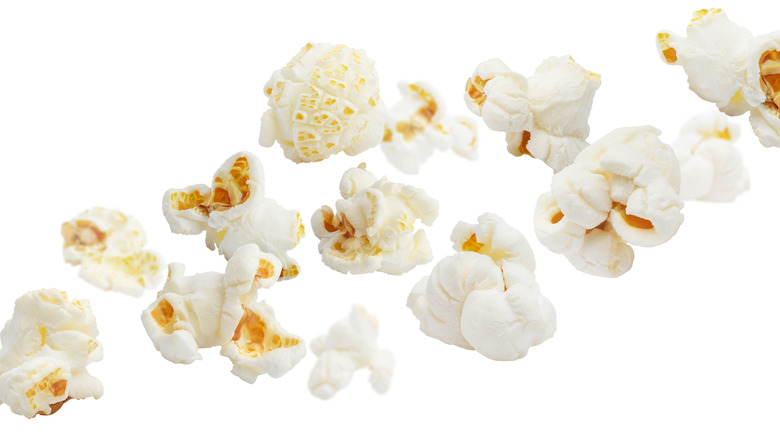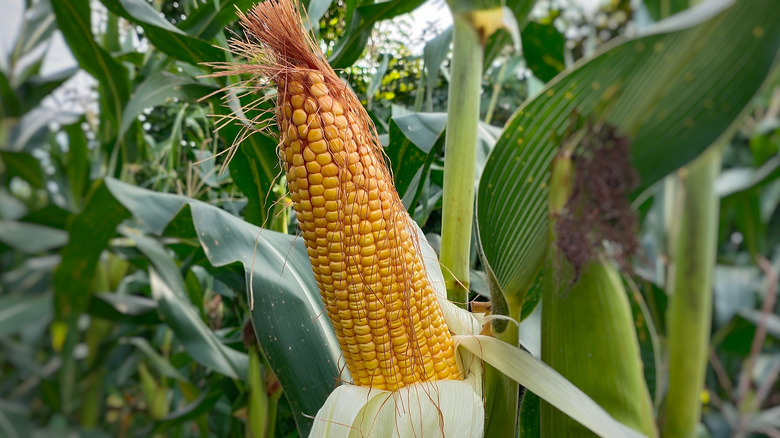Can You Make Popcorn From Regular Corn On The Cob?
As the old saying goes, there's no accounting for taste. If you admit that you don't like popcorn in mixed company, though, odds are good that you'll get at least a few quizzical looks. What's not to like, after all, about that warm and buttery treat — sometimes sweet, sometimes savory — that only reminds us of pleasant experiences at the movie theater, at the ballpark, or just some other kind of special occasion from our childhood? Even the most seasoned popcorn aficionado may find themselves wondering, though, do you really need a special kind of corn to pop up a batch, or can popcorn really be made from regular old corn on the cob?
In the 1920s, the movie industry was — well, poppin' — with record attendance and large numbers of theaters opening worldwide, per Serious Eats. By 1930, movie theater audiences reached nearly 100 million people each week, and wherever there are that many people, someone is bound to get hungry. To satisfy the crowd and pad their overall profit, enterprising theater owners added popcorn to their menu of snacks and refreshments. To this day, no movie theater worth its salt would dare not offer popcorn to its audience. Truth is, though, humans have eaten popcorn since long before the advent of talkies.
The history of popcorn
In areas of Central and South America, where corn is a native plant, people have been popping popcorn for roughly 7,000 years, as National Geographic reports. Some of the oldest evidence of popcorn, for example, was found in Peru. Corn, generally speaking, is kind of a wonder food: packed with nutrients, easy to store, and the husks are also quite versatile. For this reason, corn was one of the most traded commodities in all the pre-Columbian Americas, according to Serious Eats. And although nobody knows for sure exactly who, why, or when it happened, at some point during this period, heat and kernels of corn were brought together, just to see what might happen.
What happened, of course, is that those kernels popped. With that, popcorn was born. The popcorn back then was nothing like the popcorn we know and love today, per Serious Eats. Instead of light and fluffy popcorn, this kind of popcorn is described more like parched corn, made by drying out kernels and heating them up over fire in something like a frying pan, creating a foodstuff that was more like a corn nut. Nevertheless, this snack caught on and over the years, popcorn preparation techniques were developed, and certain kinds of corn were bred expressly for this purpose. By the 19th century, popcorn was common at fairs and other kinds of special events, and special popcorn popping machines were invented (via Serious Eats).
Popcorn from corn on the cob: a kernel of truth
All that being said, the question remains: Do you really need some special kind of corn to make popcorn? The answer to that question is no, yes, and sometimes, but mostly no.
According to Microwave Meal Prep, the only kind of corn still on the cob that can't be used to make popcorn is sweet corn. That's because the hull on sweet corn kernels isn't thick enough to trap all that heat so as to cause it to pop. Otherwise, though, it really is possible to pop up some corn from most any other variety, straight from the cob. That is, so long as one important step in the preparation process is complete.
Per Microwave Meal Prep, it's crucial that any corn meant to be popped be adequately dried. Once that's done, though, popcorn can easily be made from regular old corn, and even corn on the cob — just be sure to remove the husk. Either way, put the corn — whether on the cob or not — in an oven set on low. Just don't close the door of the oven all the way. You can also use a microwave or even possibly a dehydrator, according to Microwave Meal Prep. The corn should appear crispy, and this can take six to eight hours, per Food Hacks. Following that, though, just follow the typical steps to turn dry corn kernels into delicious popcorn, and enjoy!


